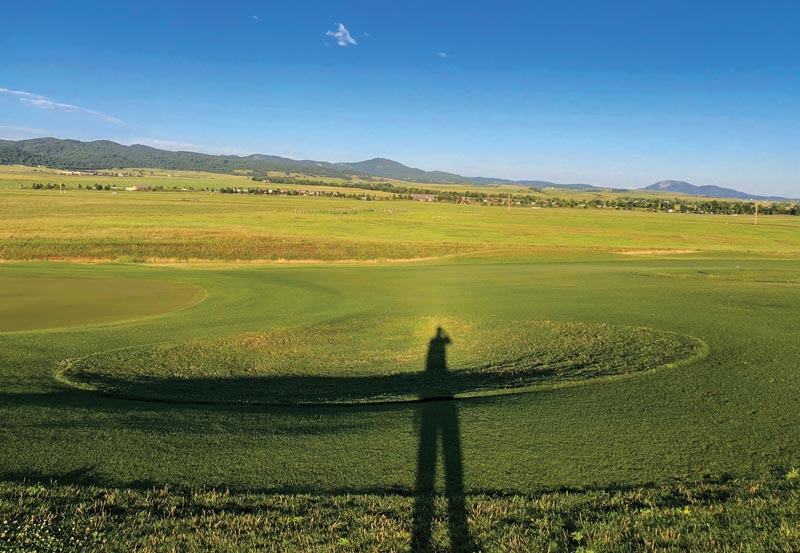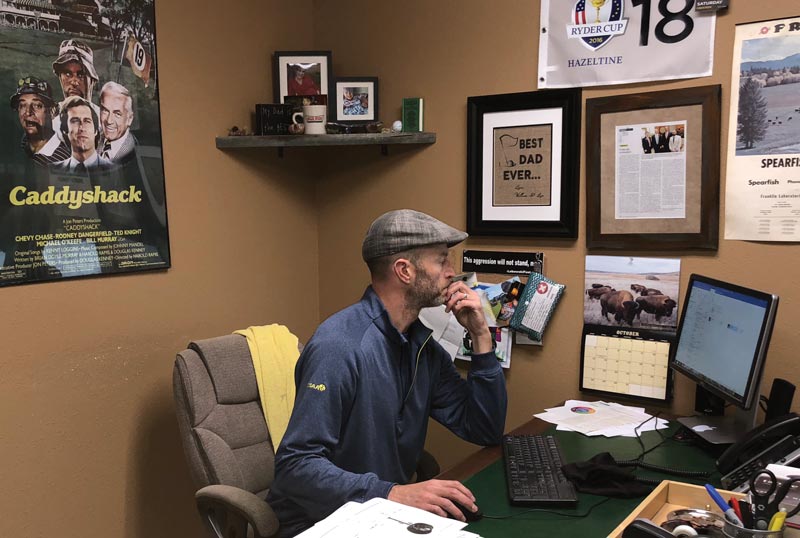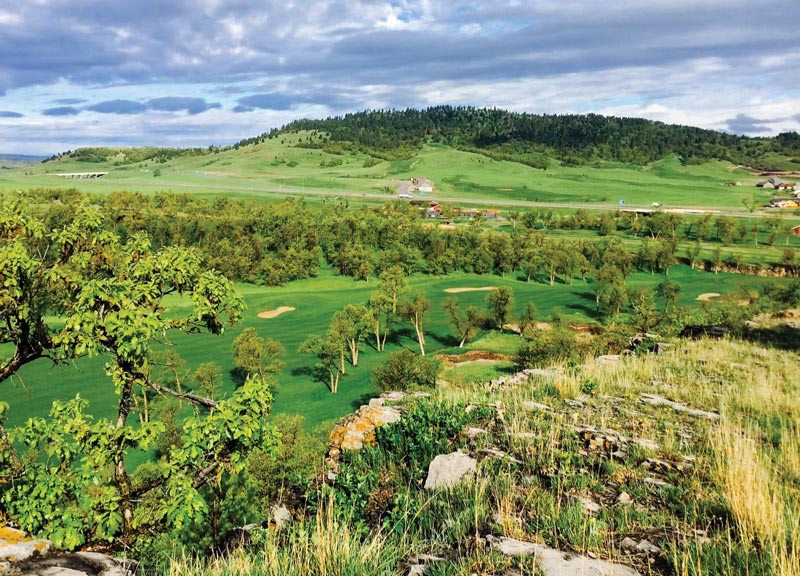
GCSAA Class A superintendent Greg Brandriet casts a shadow over the 11th hole at Elkhorn Ridge Golf Club in Spearfish, S.D. Photo by Greg Brandriet
As the 2018 golf season draws to a close, we enter that time of year where, for some of us in the north, it could be six months before we see temperatures in the 60s again. While we all have the standard list of off-season duties that must be addressed, many of us also spend this time at trade shows, conferences and chapter meetings, talking and socializing with other superintendents and industry cohorts who have one thing in common: turf.
For many of these people, it’s safe to assume that turf is their passion, and for good reason. It has meant a livelihood, a purpose, a defining career, a connection to nature and many other reasons that all contribute to a thriving industry and a lifelong activity enjoyed by millions.
So, what is your passion?
That’s a seemingly deep, introspective question. I wonder whether too often the responses are shallow and pedestrian, mainly because, well, we really don’t know. Imagine if you were asked that at the beginning of every season, or better yet, at the beginning of every day. Would your answer always be the same? Would some aspect of it always be specifically related to your occupation? Or would it be a more common yet equally valid response, such as “family,” “hunting” or “the latest IPA release from the local brewery”?
Certainly, for most of us to have gotten where we are in this business, we must love something about this job to put in the long hours, toil through high-stress situations and listen to the gripes of 18-handicappers who carry Stimpmeters in their bags. Otherwise, we never would have made it as far as we have.
Some of you might have a completely different answer, and that’s what motivated me to write this article. I share my story in the hope that it strikes a chord with other superintendents who, like me, may not have a strong passion for turfgrass or golf and have possibly taken a less common path into this field or discovered something along the way that changed their outlook on life.
I want to share what I’ve gone through during what has become a journey of personal growth and a quest to define what it means to be present and effective as a leader. Also, I personally enjoy flipping through GCM when not every article is about nematodes or nutrient ratios, so I thought I’d fill your time by sharing a part of my personal story.
I started mowing lawns when I was 12 ... oh, God, I’ve lost you already.
OK, OK, I’ll get to the point!
What is leadership?
As I flip through the various trade magazines, I’ve noticed an uptick in the number of articles on “leadership” — what is it, do you have it and how do you get it? That’s great for us, because it pertains directly to an important part of our jobs: leading people. It’s a quality I think is often overlooked, undervalued or unavailable when it comes to evaluating potential candidates for management, superintendents in particular.

“When people see the poster (far left in photo), they know how seriously I take my work,” Brandriet says. Photo by Willem Brandriet
Skimming through any issue of Forbes or Harvard Business Review will show that “emotional intelligence” typically ranks No. 1 on the list of qualities desired for upper management. Direct correlations can be made between the success of an organization and the emotional intelligence of those at any level of management, whether that’s a CEO or a second assistant in charge of the bunker crew. In the golf course maintenance world, the success and cohesion of teams like yours can depend greatly on the empathy, motivation and self-awareness of the person in charge: you.
Speaking of you — let me interject with my story and my quest to dig deeper than the typical clichés, the inspirational poster quotes regarding leadership. Certain events in my life over the past few years have raised the question, “What does it really take to become an effective leader?” For me, it has involved deep introspection, a somewhat consistent meditation practice, light reading material from my favorite gurus and real attempts to do some heavy deconstructing of my conditioning from the beginning of time.
But, dang, that’s really difficult!
Support your team, and it will respond in kind
Let me back off the therapy session and share a couple of stories that have been a part of the reason I reached this point. The first relates to an article from the August issue of GCM — written by Nate Scott and regarding “transformational leadership” — and how it relates to something I heard at our last state chapter conference.
A speaker was describing the mindset of some superintendents and other managers who intentionally keep those below them on the management tree from growing, learning or developing into leaders of their own. The reason? They don’t want to lose their assistants to another position or give them enough experience to take the manager’s job.
This blew my mind. I couldn’t believe what I was hearing — someone would actually, purposely keep someone down to make themselves look better. Wait — yes, I can, but that’s beside the point.
Don’t we want our assistants and everyone else on the crew to learn as much as they can, mainly so we don’t have to do everything ourselves?
We know one component of leadership assessment is how competent and skilled the people below you are and how they feel you’ve helped them gain the tools and experience they need. Yes, it’s inevitable that if you plan to stay where you are for the next 20 years, your assistant probably won’t stick around. But, if they sense you are loyal to their growth and success, they will return that loyalty, and they may help you train the next guy in line instead of leaving on a whim for a place where they may simply feel more valued.
A transformational leader knows that not just his assistant, but the entire team, will support him if he supports them.
The concept of transformational leadership also applies to staff retention. This can be a challenge for us in this temperate zone, where winter sometimes extends into what we call “third winter.” What does your staff look like from year to year? Do you have enough influence to keep good people coming back on a yearly basis? I’ve worked at places where the amount of turnover was astounding.
There’s no doubt this can cause a tremendous drain on the superintendent and the crew in many ways — lost hours of training, scheduling, keeping the team focused on the overall process (a challenge when the personnel is constantly in flux).
Turnover can have many causes — one of which is that the work culture needs to change. Change starts with those of us at the top, and our attitude, approach and demeanor are directly related to the performance of the staff we manage.
Who are you? Really
The next part of this journey is a bit more personal, yet again takes place at a South Dakota GCSA conference a few years ago.
I was sitting in the same old room, in the same old hotel, drinking the same cup of coffee as the last year, about to listen to John Jenson, an author and corporate speaker specializing in influence, change and perspective.
“Huh,” I thought, “this is different. No mention of any turf-related jargon in there. I wonder what this could be about?” Well, it turned out to be one of the best seminars I’ve ever sat through at any golf conference for exactly that reason: It had nothing to do with turf.

A view of Elkhorn Ridge Golf Club’s par-5 fifth hole, which shows the course’s elk-track bunkers leading to Elkhorn Peak in the background. Photo by Greg Brandriet
What was it about? You. Who are you? What kind of boss are you? How do you lead your team? How do you handle adversity? These questions asked by John (and very reluctantly answered by a suddenly uncomfortable group of men) gave me a promising feeling that we were about to get real. It was also clear that most of us had never been asked any of these questions.
Let me give you an example. At one point, Jenson asked us to write down the answer to this question: “Who are you, and what do you do?” We then were to share the answers with the class. Many answers were exactly what you’d expect: “I’m a superintendent, and I take care of the golf course,” or some variation of that. A few responses were unique and used words like “father” or “boss” or “leader,” but I had no idea what to write down.
All I had written on the paper was, “I am ... ” Ultimately, I discovered that might be the answer. I didn’t answer that way on purpose, and when it came time for my audible response, I blacked out and winged it. Who knows what I said. But the struggle I had defining myself with a few words hit me at the core.
Afterward, I tried to share my awakened curiosity with the other guys in the group, but my feelings about the class were not reciprocated. A few classmates seemed to be terrified by the experience, and I noticed that some people had not returned after the break. I later realized that many of us were ill-prepared to be asked who we really were, to be challenged to look inward and to dare to engage in a process of self-discovery.
In the aftermath of this seminar, I returned home with a slight shift in attitude, not only toward my career, but toward my personal life as well. Books on spirituality, leadership and conscious living kept landing in front of me. I found myself slowly absorbing the ideals of leadership, self-awareness and spirituality, specifically how they all relate to the workplace environment.
Yet, as great as all of this sounds, I also began to realize that humans, myself included, live most of our lives not knowing who we are. When we begin to deconstruct our conditioning from societal institutions that guide us unconsciously through life, it can get scary, really fast! So, I’ll back off that for now and settle back in a happier place, a place where all of us are capable of creating a better work environment.
Questions with no wrong answers
Unfortunately, after all this, I don’t have the answer for you. Your journey is yours. This is mine. But I can share a few simple questions that I ask myself every so often. The answers are never wrong, and they keep me on this path.
How do I respond when things don’t go as planned? Whether it be an irrigation break on championship morning, a no-show employee or a broken hydraulic line that leaked across three greens before Tommy finally looked up from his “Sunday Beatz” playlist, many things can send the day into a tailspin. How we react to different situations is a choice with an infinite ripple of consequences, so make it a good one.
How do I handle criticism? Staying calm under verbal duress of any kind is challenging. Arming yourself with the tools to remain calm and deflect criticism takes a lot of practice, study and patience. Many of us tend either to reciprocate or elevate the verbal attack. Or we take it personally and stew over it for too long until it robs us of valuable time and energy, and the lesson is often overlooked.

The canyon rim looms over Polo Creek and the par-5 No. 14 hole at Elkhorn Ridge. Photo by Greg Brandriet
And the single most important question I’ve ever asked myself is this: How did my actions contribute to this situation/conflict/relationship? All of our personal relationships and the energy around them are the result of our direct or indirect participation in them. Accepting the infinite possibilities of the ways that we affect all of those around us is the key to understanding that the lessons are always found right in the mirror.
This teaching came to me a couple of years ago — it was simply described as “co-creation.” It’s a profound concept that, in my limited language, I can only describe as an infinite web of the cause and effect of human energy.
Once I had just barely tapped into this knowledge, I began to see how my actions and reactions to anything and everything had a direct effect on the amount of stress, happiness, goodness or badness in my life. I also realized how much I didn’t know about myself, but that a glimpse was given to me in every moment of life, whether I was raking bunkers, giving a presentation or trying to get my son to brush his teeth.
But to see those opportunities, you must be present — not just physically, but also mentally, spiritually present. That can be difficult. Really, it’s impossible. I fail almost daily. But not in a bad way, because the feelings of failure and frustration are the windows to growth.
Sorry, I’m leading you all down a wormhole here. Some of you turned the page after the first paragraph. Either way, the work I’ve done and the concepts I’ve presented here can’t be explained in one article, one book or one lifetime. For me, it’s all about sharing openly what I’ve gone through in the hope that it resonates with even just a few of you, because that’s what it took for me — someone to share what they’d experienced on the path to successful leadership.
Allow me to wrap up this mess and put a bow on it with quotations from two of my favorites: Lao Tzu, from the “Tao Te Ching,” verse 17; and Ty Webb, “Caddyshack,” which is a cheap attempt to get a laugh out of you.
“When the Master governs, the people are hardly aware that he exists ... When his work is done, the people say, ‘Amazing, we did it, all by ourselves!’”
“There’s a force in the universe that makes things happen. And all you have to do is get in touch with it, stop thinking, let things happen, and be the ball.”
There. That should clear things up for you.
Greg Brandriet is the GCSAA Class A superintendent at Elkhorn Ridge Golf Club in Spearfish, S.D. He is a nine-year association member and a GCSAA grassroots ambassador.